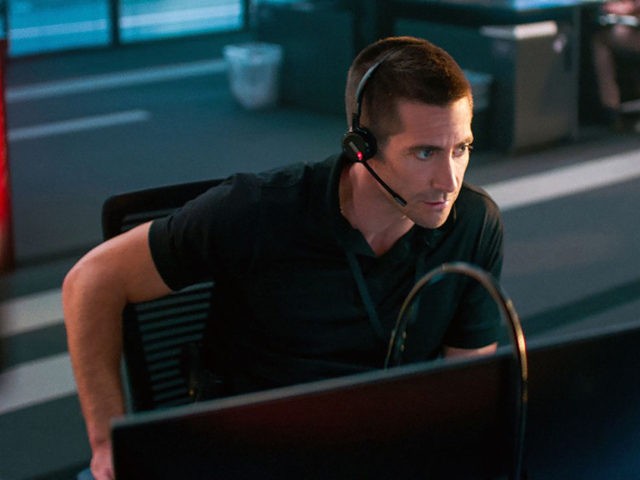Netflix’s big weekend release, The Guilty, is basically a filmed stage play and one that doesn’t hold up to storytelling scrutiny.
Jake Gyllenhaal plays Joe Baylor, an LAPD officer temporarily assigned to handle 9-1-1 calls until something in his past is resolved. Tomorrow is his do-or-die day, the day of his “hearing,” and he’s pretty confident he’ll be cleared and back out on the streets.
Not long before his shift ends, he gets a call from a tearful woman named Emily. At first, it sounds like she’s confused Joe with her daughter. Then Joe figures out she’s only pretending. She’s been abducted and needs help. Joe spends the rest of the movie trying to save her.
The Guilty is a “COVID movie,” a single location deal reportedly shot over 11 days. Antoine Fuqua directs a script by Nic Pizzolatto based on a 2018 Danish movie of the same name.
The Guilty has three significant problems. The first is that Joe is an unlikable, charmless jerk, and since he’s the whole show, that makes for a rough sit, even at 90 minutes.
Watch below:
The second problem is that a major plot turn makes no sense. All someone had to do was say something. This someone had plenty of chances to say this something. Anyone in this situation would have said this something. The fact that this someone never said this something is beyond contrived.
The third problem is that, except for Joe, all the other characters are troubled, barely coherent voices on the phone, and we never get a grasp of them as full-bodied human beings. Naturally, we don’t want Emily to get hurt, but we feel no emotional connection to her beyond the natural human instinct to not want others to get hurt.
All of this adds up to a feature film you’re never invested in.
Back in 1965, future Academy Award-winning director Sydney Pollack launched his career with a little chamber piece called The Slender Thread. Sidney Poitier plays Alan, a student who volunteers for an overnight crisis line. He’s expecting another slow, uneventful night when a woman named Inga (Anne Bancroft) calls in. She’s taken an overdose of pills and wants to speak to someone as she dies.
The similarities to The Slender Thread and The Guilty are apparent but stop there. The Slender Thread works for several reasons The Guilty does not. First, Poitier’s Alan is young and innocent and suddenly in over his head, so we not only empathize with him, we want him to save Inga because we know if he doesn’t, he’ll carry that guilt for the rest of his life.
Secondly, Bancroft’s Inga is a real, living human being, a full-bodied character, whereas The Guilty’s Emily feels more like a plot device than a person.
The self-defeating subtext in The Guilty is pretty obvious. Joe is a white LAPD cop, and in this fascist age of Woke and Black Lives Matter, we are not allowed to like Joe, not even a little bit, not even in that way we sometimes sympathize with reprehensible anti-heroes. This kills the whole movie, as does an overwrought third act full of BIG and IMPORTANT acting.
One of the basic rules of screenwriting and storytelling is to manipulate your audience into sympathizing with your protagonist. That’s why the first episode of the Sopranos has our mob boss protagonist, Tony Soprano, infatuated with a family of ducks.
To appease the McCarthyism of woke, over and over, we see these basics of storytelling tossed aside, and the result is utterly disposable content like The Guilty.
The failure of The Guilty is not Gyllenhaal’s fault. He made one of the 21st century’s great sociopaths oddly appealing.
Woke is what’s killing movies and TV. There’s no shortage of content out there, but in ten years, no one will remember it. Art we remember. Propaganda has a shorter shelf life than an open can of tuna.
Follow John Nolte on Twitter @NolteNC. Follow his Facebook Page here.

COMMENTS
Please let us know if you're having issues with commenting.